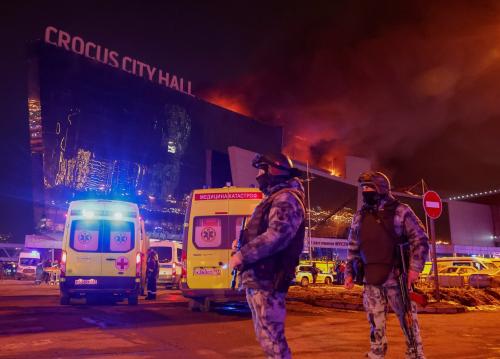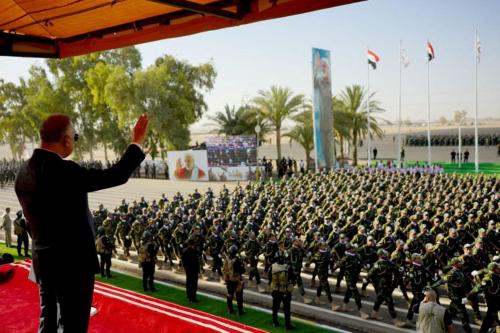Editors’ Note: Al-Shabab’s operational capacities and intimidation power have grown in the past year, writes Vanda Felbab-Brown. Many of Kenya’s counterterrorism policies have been counterproductive, and counterinsurgency efforts by the African Union Mission in Somalia (AMISOM) have at best stagnated. This piece was originally published by The Cipher Brief.
April 2 marked one year since the Somali terrorist group al-Shabab attacked the Garissa University in Kenya and killed 148 people, galvanizing Kenya to intensify its counterterrorism efforts. Yet al-Shabab’s operational capacities and intimidation power have grown in the past year. Many of Kenya’s counterterrorism policies have been counterproductive, and counterinsurgency efforts by the African Union Mission in Somalia (AMISOM) have at best stagnated. State building in Somalia is only creeping, with service-delivery by the federal government and newly formed states mostly lacking. Politics continues to be clan-based, rapacious, and discriminatory, with the forthcoming 2016 elections in Somalia thus far merely intensifying political infighting.
Al-Shabab: A rejuvenation
Despite internal and external threats to its effective functioning, al-Shabab is on the upswing again. It has carried out dozens of terrorist attacks within Somalia, including against hotels used by government officials as workspaces and housing, and on beaches and in markets throughout the country. It has raised fear among the population and hampers the basic government functionality and civil society mobilization.
In February 2016, al-Shabab, for the first time, succeeded in smuggling a bomb onboard a flight from Mogadishu. Disturbingly, it has been retaking cities in southern Somalia, including the important port of Merka. It has also overrun AMISOM bases and seized weapons and humvees: one such attack on a Kenyan forward-operating base was likely the deadliest ever suffered by the Kenyan military. Al-Shabab’s operational capacity has also recovered from the internal rifts between its anti-foreign-jihadi, pro-al-Qaida, pro-ISIS, and Somalia-focused factions.
Not all the power jockeying has been settled, and not all leadership succession struggles have been resolved. Moreover, an ISIS branch independent of and antagonistic to al-Shabab is trying to grow in Somalia and has been battling al-Shabab (in a way that parallels the ISIS-Taliban tangles in Afghanistan). Nonetheless, al-Shabab is once more on the rise and has recovered its financing from charcoal, sugar, and other smuggling in southern Somalia, and from taxing traffic and businesses throughout its area of operation, including in Mogadishu.
Although the terrorist violence is almost always claimed by al-Shabab, many of the attacks and assassinations are the work of politicians, businessmen, and clans, intimidating rivals or seeking revenge in their disputes over land and contracts. Indeed, with the clock ticking down to the expected 2016 national elections in Somalia, much of the current violence also reflects political prepositioning for the elections and desire to eliminate political rivals.
Kenya and AMISOM: Don’t sugarcoat it
In contrast to the upbeat mood among al-Shabab, AMISOM efforts have at best been stalled. With the training of Somali national forces going slowly and the force still torn by clan rivalries and shackled by a lack of military enablers, the 22,000-strong AMISOM continues to be the principal counterinsurgency force. Counterterrorism attacks by U.S. drone and special operations forces complicate al-Shabab’s operations, but do not alter the balance of power on the ground. In its ninth year now, and having cost more than U.S.$1 billion, AMISOM continues to be barricaded in its bases, and many of Somalia’s roads, even in areas that are supposedly cleared, are continually controlled by al-Shabab. In cities where AMISOM is nominally in charge, al-Shabab often rules more than the night as AMISOM conducts little active patrolling or fresh anti-Shabab operations even during the day. Rarely are there formal Somali forces or government offices to whom to hand over the post-clearing “holding and building” efforts. There is little coordination, intelligence sharing, or joint planning among the countries folded under the AMISOM heading, with capabilities vastly uneven. The principle benefit of the Burundi forces in Somalia, for example, is that they are not joining the ethnic infighting developing in their home country.
Ethiopia and Kenya still support their favorite Somali proxies. For Kenya, the key ally is Sheik Ahmed “Madobe,” a former high-level al-Shabab commander who defected to create his Ogadeni anti-Shabab militias, Ras Kamboni, and who in 2015 got himself elected president of the newly-formed Jubaland state. Along with Madobe and other Ogadeni powerbrokers, Kenyan Defense Forces control the Kismayo port. Like al-Shabab, they allegedly illegally tax smuggled sugar, charcoal, and other goods through the port and southern Kenya. In addition to these nefarious proceeds on the order of tens to hundreds of millions of U.S. dollars, Kenya’s other interests in Somalia often clash with those of Ethiopia and the Somali national government, including over projecting power off Somali coast and strengthening local warlords and militias who promise to keep Ogadeni mobilization in Kenya down.
At home, Kenya’s counterterrorism activities have been not only parochial, but often outright counterproductive. Post-Garissa dragnets have rounded up countless Kenyan ethnic Somalis and Somali immigrants and refugees. Entire communities have been made scapegoats. For a while, the Kenyan government tried to shut down all Somali hawala services based in Kenya as well as to expel Somali refugees and shut down their camps. Accusations of torture, disappearances, and extrajudicial killings by Kenyan Defense Forces, the police, and other security agencies are widespread. Meanwhile, despite U.S. counterterrorism training and assistance such as through the Security Governance Initiative, debilitating corruption plagues Kenya’s security forces and agencies.
Somalia’s government: Old and new mires
The Somali federal government and the newly formed state-level administrations mostly falter in delivering services that Somali people crave. Competition over state jobs and whatever meager state-sponsored resources are available continue to be mired in clan rivalries and discrimination. Unfortunately, even newly formed (Jubaland, Southwest, and Galmudug) and still-forming states (Hiraan and Middle Shabelle) have not escaped rapacious clan politics. Dominant clans tend not to share power and resources with less numerous ones, often engaging in outright land theft, such as in Jubaland. Civil society contributions have been marginalized. Such misgovernance and clan-based marginalization, as well as more conservative religious politics, are also creeping into Somaliland and Puntland, the two more stable states. Throughout Somalia and in Northeast Kenya, al-Shabab is skillfully inserting itself into clan rivalries and mobilizing support among those who feel marginalized.
The expected 2016 national elections further intensify these clan and elite political rivalries. The hope that the elections could take the form of one man, one vote was once again dashed, with the promise that such elections will take place in 2020. Instead, the 2016 electoral process will reflect the 4.5 model in practice since 2004, in which the four major clans get to appoint the same proportion of the 275 members of the lower chamber and the minority clans will together be allotted half the MP positions that each major clan gets. This system has promoted discriminatory clan rivalries and elite interests. The 54 members of the upper chamber will be appointed by Somalia’s states, including the newly formed and forming states. This arrangement requires that the state formation process is finished well before the elections, but also problematically increases the immediate stakes in the state formation. Finalizing the provisional constitution and getting it approved by a referendum—another key item of the Vision 2016 agreed to by the Somali government and international donors—is also in question.
Perhaps the greatest progress has been made in devolving power from Mogadishu through the formation of subnational states. But there is a real risk that rather than bonding Somalis with state structures as the international community long hoped for and prescribed, the power devolution to newly formed states will instead devolve discriminatory and rapacious politics.



Commentary
Why are efforts to counter al-Shabab falling so flat?
April 5, 2016